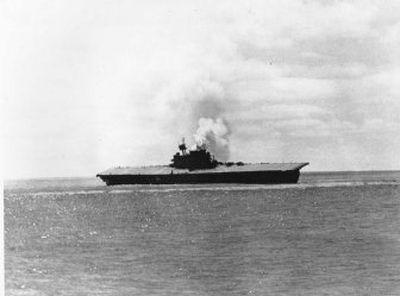U.S. victory at Midway changed course of WWII

HONOLULU – Six months after the attack on Pearl Harbor, a weakened and outnumbered U.S. fleet limped north to confront a flotilla of Japanese ships advancing on the remote Pacific atoll of Midway.
A Japanese victory would have cost the U.S. a strategically critical scrap of land between Hawaii and Japan, and could have decimated U.S. naval forces. Instead, the U.S. sank four Japanese aircraft carriers and snatched the military advantage from Tokyo.
Today marks the 65th anniversary of the start of the three-day battle that changed the course of World War II. Three Midway veterans in their 80s and 90s and the current Pacific Fleet commander will visit the island 1,300 miles northwest of Honolulu for a ceremony hosted by the U.S. Fish and Wildlife Service, which today runs a nature reserve on the atoll.
“Americans like underdogs, and here we are underdogs,” said Donald Goldstein, a University of Pittsburgh history professor. “I think that’s what made it so good – that we shouldn’t have won and we did.”
The victory came after a string of U.S. setbacks in the Pacific.
Japanese forces ousted the U.S. from Wake Island, Guam and the Philippines in rapid succession in the months after Pearl Harbor. Japan also drove the British, U.S. allies, from Singapore.
By targeting Midway, the Japanese navy aimed to take control of the U.S. patrol plane base there and destroy what was left of the U.S. Pacific Fleet. Conquering the island was a way to protect the Japanese homeland from U.S. air raids and prevent the U.S. from interfering with Tokyo’s plans to dominate the Asia-Pacific.
One of the U.S. aircraft carriers sent to confront the Japanese, the USS Yorktown, had been hastily patched up just a few weeks after being severely damaged in the Battle of the Coral Sea.
George Chockley, one of the veterans visiting Midway, was a 22-year-old chief petty officer on the USS Enterprise during the battle.
“I was just a young kid. I didn’t have sense enough to be afraid,” he said with a laugh during a telephone interview from his son’s home in North Carolina. Chockley, 87, of Mebane, N.C., ran the aircraft carrier’s public address system and maintained its navigational instruments.
The U.S. thwarted Japan’s intentions with a mixture of code breaking, smart decisions and luck.
The Navy’s intelligence experts deciphered encrypted Japanese communications, giving Adm. Chester Nimitz, the U.S. Pacific Fleet commander, the precise time of the planned assault and the route Japan’s ships would travel to Midway.
Both nations lost dozens of fighter planes, dive bombers and torpedo planes in the fight to sink each other’s aircraft carriers.
But the Americans had the benefit of knowing roughly where the Japanese were and how many ships their enemies had. Japan’s commanders were forced to guess about their foes.
The U.S. lost one carrier, 145 planes and 307 men.
Japan lost four aircraft carriers, a heavy cruiser, three destroyers, 291 planes and 4,800 men.
The defeat was so overwhelming that the Japanese navy kept the details a closely guarded secret, preventing the story of the battle from coming to light in Japan until after the war.
Goldstein, the co-author of “Miracle at Midway,” said Japan’s military never recovered from the loss because its industrial sector was unable to manufacture replacement aircraft carriers quickly enough to retake the advantage.
Over the next three years, U.S. forces moved westward after hard-fought battles to deny Japan access to Guadalcanal and to retake Guam. The island-hopping led the U.S. to Iwo Jima and Okinawa before Japan surrendered after the atomic bombings of Hiroshima and Nagasaki in 1945.
“Midway made it possible for us to take the offense. Before that it had been all defense,” Goldstein said.